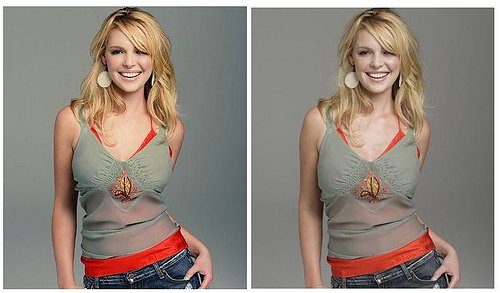
There is no secret that the fashion world uses a bit of photo-trickery to ensure models look their best.
Any fashion magazine is full of pictures of Amazonian celebrities with endless legs, flawless skin, and not a wrinkle in sight.
However, health organizations have warned that such digital enhancement promotes unrealistic expectations of body image, especially among young girls.
Two computer scientists have said that consumers should be told how much altering has been done on a particular image – and believe they have found a way of quantifying it to offer a universal “health warning” on magazine images.
Professor Hany Farid, the man behind the project, wrote : “Impossibly thin, tall, and wrinkle-and blemish-free models are routinely splashed into billboards, advertisements, and magazine covers.”
Prof. Hany Farid and Eric Kee, from Dartmouth College, in New Hampshire, listed the troubling side-effects of altered images as a primary motivation of the project to provide consumers with more information on “photoshopped” images.
“The ubiquity of these unrealistic and highly idealized images has been linked to eating disorders and body-image dissatisfaction in men, women, and children,” the two computer scientists said.
Using a computer programme to highlight the differences between a natural and retouched picture, they have now come up with a simple system under which a picture scores a “1” when there is little retouching and “5” when there are significant changes.
The rating system accounts for two types of adjustments made in photos: geometric adjustments that slim the arms, legs, and torso; and photometric alterations that augment skin tone and removes wrinkles, blemishes, and cellulite.

The researchers sought to break down an image’s retouching by producing statistics which detail changes made to each photograph.
“We start with the before-and-after digital images, from which we automatically estimate the geometric and photometric changes, effectively reverse-engineering the manipulations that a photo retoucher has made,” Prof. Hany Farid said.
The specialists analyzed 468 sets of unedited and retouched photographs. They then used a simplified mathematical description of augmentations made to a model’s features, such as their shape or their skin tone.
Each altered photograph was scored between one and five, with five representing a heavy retouching. Volunteers were each asked to score from 1 to 5 how similar each pair of pictures was.
Prof. Hany Farid and his student, Eric Kee, found a close correlation between their computerized assessment and the human opinion, suggesting the technique could be used to come up with a rating that could be published alongside the image.
“Now what we have is a mathematical measure of photo retouching,” Professor Hany Farid, along with doctoral student Eric Kee, wrote in the journal Proceedings of the National Academy of Sciences.
“We can predict what the average observer would say.
“We propose that the interests of advertisers, publishers and consumers may be protected by providing a perceptually meaningful rating of the amount by which a person’s appearance has been digitally altered.
“When published alongside a photo, such a rating can inform consumers of how much a photo has strayed from reality, and can also inform photo editors of exaggerated and perhaps unintended alterations to … appearance.”
Prof. Hany Farid said that it is understandable why magazines go to such great lengths to edit a photo to perfection.
“Publishers have legitimate reasons to alter photographs to create fantasy and sell products, but they’ve gone a little too far. You can’t ignore the body of literature showing negative consequences to being inundated with these images.”
Prof. Hany Farid and Eric Kee aren’t the only ones who have seen the negative effects of over-editing.
In June, the American Medical Association called for industry standards in photo altering, saying: “We must stop exposing impressionable children and teenagers to advertisements portraying models with body types only attainable with the help of photo editing software.”